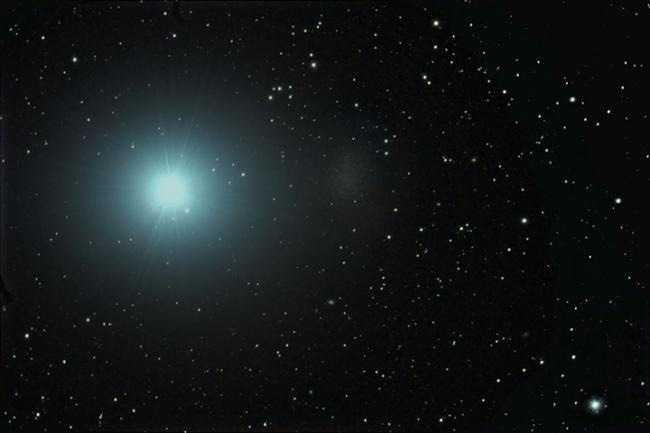Two astrophysicists at the Center for Astrophysics (CfA), a Harvard and Smithsonian collaboration, have recommended a method to view a supermassive black hole said to be the second closest to the Earth. It is 3 million times the mass of the Sun and is accommodated by the dwarf galaxy Leo I.

The ultra-faint Milky Way companion galaxy Leo I appears as a faint patch to the right of the bright star, Regulus. Image Credit: Scott Anttila Anttler
The supermassive black hole, christened Leo I*, was first suggested by an autonomous team of astronomers toward the end of 2021. The team observed stars accelerating as they neared the center of the galaxy—proof for a black hole—but could not directly image the emission from the black hole.
At present, CfA astrophysicists Fabio Pacucci and Avi Loeb recommend a new method to confirm the existence of the supermassive black hole; their efforts have been illustrated in an article published recently in The Astrophysical Journal Letters.
Black holes are very elusive objects, and sometimes they enjoy playing hide-and-seek with us. Rays of light cannot escape their event horizons, but the environment around them can be extremely bright—if enough material falls into their gravitational well. But if a black hole is not accreting mass, instead, it emits no light and becomes impossible to find with our telescopes.
Fabio Pacucci, Study Lead Author, Center for Astrophysics | Harvard & Smithsonian
This is the problem with Leo I—a dwarf galaxy so empty of gas available to accrete that it is repeatedly branded as a “fossil.”
In our study, we suggested that a small amount of mass lost from stars wandering around the black hole could provide the accretion rate needed to observe it. Old stars become very big and red—we call them red giant stars. Red giants typically have strong winds that carry a fraction of their mass to the environment. The space around Leo I* seems to contain enough of these ancient stars to make it observable.
Fabio Pacucci, Study Lead Author, Center for Astrophysics | Harvard & Smithsonian
“Observing Leo I* could be groundbreaking,” says Avi Loeb, the study’s co-author. “It would be the second-closest supermassive black hole after the one at the center of our galaxy, with a very similar mass but hosted by a galaxy that is a thousand times less massive than the Milky Way. This fact challenges everything we know about how galaxies and their central supermassive black holes co-evolve. How did such an oversized baby end up being born from a slim parent?”
Several years of studies reveal that the majority of enormous galaxies accommodate a supermassive black hole at their center, and the mass of the black hole is a tenth of a percent of the entire mass of the spheroid of stars encompassing it.
“In the case of Leo I,” Loeb continues, “we would expect a much smaller black hole. Instead, Leo I appears to contain a black hole a few million times the mass of the Sun, similar to that hosted by the Milky Way. This is exciting because science usually advances the most when the unexpected happens.”
Thus, when can we anticipate an image of the black hole?
“We are not there yet,” Pacucci explains.
The researchers have gained telescope time on the space-borne Chandra X-ray Observatory and the Very Large Array radio telescope in New Mexico and are presently examining the new data.
Pacucci states, “Leo I* is playing hide-and-seek, but it emits too much radiation to remain undetected for long.”
Journal Reference:
Pacucci, F., et al. (2022) Accretion from Winds of Red Giant Branch Stars May Reveal the Supermassive Black Hole in Leo I. The Astrophysical Journal Letters. doi.org/10.3847/2041-8213/ac9b21